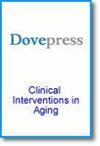Associations Between Gait Speed and Fat Mass in Older Adults
IF 3.7
3区 医学
引用次数: 0
Abstract
Purpose: Although both gait speed and fat mass are crucial for healthy aging, evidence suggests that the associations between these components remain unclear. Therefore, the main purpose of the study was to examine the associations between gait speed and fat mass.Patients and Methods: In this cross-sectional study, we recruited 643 older men and women aged > 60 years. Fat mass was assessed using bioelectrical impedance analysis, while gait speed was determined by calculating the time an individual has taken to walk across a 4.6-m distance. Receiver operating characteristic (ROC) curves and odds ratios (OR) were performed to determine cut-off points and mutual associations.
Results: In older men, the optimal threshold of gait speed to detect high level of fat mass was 1.40 m/s with the area under the curve (AUC) being 0.82 (95% CI 0.76– 0.89, p < 0.001). In older women, the optimal cut-off point was 1.37 m/s (AUC = 0.85, 95% CI 0.81– 0.90, p < 0.001). Older men and women who walked below the newly developed threshold were approximately 12 times more likely to have high level of fat.
Conclusion: In summary, newly developed cut-off points of gait speed have adequate discriminatory ability to detect older men and women with high level of fat mass. Although gait speed may be considered as a satisfactory screening tool for fat mass, its utility in clinical practice needs to be further investigated.
Keywords: body composition, physical performance, aging, cut-points, associations
老年人步速与脂肪量之间的关系
目的:虽然步态速度和脂肪量对健康老龄化至关重要,但有证据表明,这两个因素之间的关系仍不明确。因此,本研究的主要目的是探讨步速与脂肪量之间的关系:在这项横断面研究中,我们招募了 643 名 60 岁以上的老年男性和女性。脂肪量通过生物电阻抗分析进行评估,步速则通过计算一个人走过 4.6 米距离所需的时间来确定。通过接收器操作特征曲线(ROC)和几率比(OR)来确定临界点和相互关系:在老年男性中,检测高脂肪含量的最佳步速临界点为 1.40 米/秒,曲线下面积(AUC)为 0.82(95% CI 0.76-0.89,p <0.001)。在老年妇女中,最佳分界点为 1.37 米/秒(AUC = 0.85,95% CI 0.81- 0.90,p < 0.001)。行走速度低于新制定的临界点的老年男性和女性,其脂肪含量较高的可能性大约高出 12 倍:总之,新开发的步速临界点具有足够的判别能力,可以检测出脂肪含量高的老年男性和女性。尽管步速可被视为一种令人满意的脂肪含量筛查工具,但其在临床实践中的实用性仍有待进一步研究。
本文章由计算机程序翻译,如有差异,请以英文原文为准。
求助全文
约1分钟内获得全文
求助全文
来源期刊

Clinical Interventions in Aging
GERIATRICS & GERONTOLOGY-
CiteScore
6.20
自引率
2.80%
发文量
193
期刊介绍:
Clinical Interventions in Aging, is an online, peer reviewed, open access journal focusing on concise rapid reporting of original research and reviews in aging. Special attention will be given to papers reporting on actual or potential clinical applications leading to improved prevention or treatment of disease or a greater understanding of pathological processes that result from maladaptive changes in the body associated with aging. This journal is directed at a wide array of scientists, engineers, pharmacists, pharmacologists and clinical specialists wishing to maintain an up to date knowledge of this exciting and emerging field.
 求助内容:
求助内容: 应助结果提醒方式:
应助结果提醒方式:


